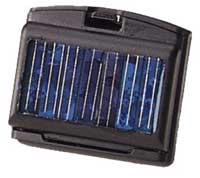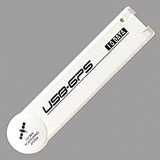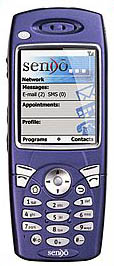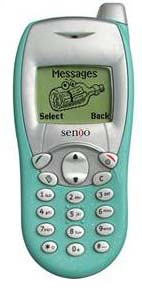 |
||
|
||
| ||
New products on the marketIn February Sunpower Systems has created a small module of a solar battery based on a usual Li-ion one. 15 minutes under the sun will be enough for a minute of talking when used in a mobile phone, and 5 hours is enough for complete charge of the battery.  The modern battery models are compatible with Nokia 51xx, 61xx and Motorola Startac. The price is $50. The company plans to provide compatibility also with other cellular phones. February was rich for announces connected with power sources, for example Electric Fuel Corp has made a new step in developing of quite rare today zink-oxygen batteries. These batteries take energy from the reaction of zink oxydation in air space. Their advantage is cheapness, reliability, huge energy reserve, small size and ecological compatibility. The downside is only one - disposability. Electric Fuel Corp plans to use zink-oxygen batteries in mobile phones: they allow to prolong speaking time from 3-5 (with the Li-Ion battery) to 10-17 hours or from 70-90 to 300 hour in standby mode. Matsushita Battery Industrial Co. has developed a flat Li-Ion battery (5.3x30x48 mm, 16.5 g) with the record density of energy accumulation (370 W.h/l, what is 16% higher than of the usual Matsushita batteries). The battery's capacity is 755 mAh. The dimensions and capacity allow using the battery in mobile phones of W-CDMA standard. The CGA533048 model will start being produced in March. At the first stage the production will amount 20 million batteries a year. In February Toshiba introduces new miniature enhanced Li batteries called Advanced Lithium Batteries (ALB). They state that at the smaller size the batteries do not yield to their predecessors in electric capacity. ALB-batteries take the energy from polymer-like liquid. The minimal thickness is around 1 mm (the standard Li-Ion batteries are 5 mm). In capacity to volume correlation the ALB-batteries outperform all their larger competitors. They are priced, though, 20% more than Li-Ion ones, but at the same time they are much more compact. Toshiba has officially introduced ALB-batteries on Monday and exactly that day Ericsson announced an installation of these batteries in their mobile phones T28 World. Besides, the ALB-batteries are going to be used in pocket computers also. Toshiba announced also that they are holding talks on usage of these batteries with some notebook manufacturers. They assume that notebooks with ALB-batteries will appear by the end of 2001. As for installation in Toshiba notebooks they say that it will be obviously done in 2002. Today Toshiba produces 1.7 million ALB-batteries a month and they are going to lift the release up to 3 million pcs by the end of the year. That's all what I had to say about energy sources. Toshiba, who had developed a monochrome OEL-display (organic electroluminescence technology) with 2.85" diagonal said that they were going to complete development of the color version for mobile devices (pocket PC, mobile phones etc.) and start their production by the end of the year. Due to lack of the need in backlight the OEL-displays consume less energy and are thinner than standard LCDs. The new devices market is expected to grow from $25.5 million in 1999 to $1.7 billion in 2005. Seiko Epson announced that they started production of color LCDs according to TFD (Thin-Film Diode) technology. They will be able to display up to 260000 colors. Epson offers two modifications for realization of full color 6-bit image on a small LCD: the first variant is a 6-bit input signal and a 6-bit panel which can provide these 260,000 colors, the second variant is 6 bits on the input and a 4-bit panel which creates an impression of a 6-bit image due to the signal conversion. The second version is more economical and cheaper: it consumes 20%-30% less energy. Such displays will appear this year and will be intended for PDA and mobile phones manufacturers. Sanyo Electric Co., Ltd. is going to start production of CCD-martices iGT99263 for mobile phones. The matrix consists of 110,000 pixels at the size of 11.2X11.2X6.7 mm (including LSI signal processor and lens). The energy consumed constitutes around 90 mW in shooting mode at 15 fps and around 65 mW at 5 fps. Sanyo developers state that while consuming the same quantity of energy as CMOS-matrices, CCD-matrices have sensitivity several times more. The new matrix can operate at the illumination equal only to 5 lux. The estimated price of the iGT99263 is $65, the mass production (up to 500 thousand pcs a month) will start by the end of 2001. Elpida Memory is going to create a new class of memory modules which are named consumer DRAM chips. They are intended for portable Internet-devices and they also will be able to replace more expensive and slower SRAM modules in cellular phones and other wireless mobile devices. Elpida was founded last year as a result of amalgamation of subdivisions of marketing and development of DRAM modules of Hitachi and NEC companies. According to Elpida, new DRAM modules will work at low voltage than today's DDR DRAM chips (2.5 V); they will be smaller in dimensions than the modern DRAM modules and will be compatible with interfaces of modern SRAM modules used in mobile phones. Meanwhile, the Bell Labs researchers have solved the problem of completely silicon chips for radio signal receipt in base mobile communication stations. At ISSCC they stated that usage of their silicon receiving chips will tremendously decrease the cost of base stations. Today the receiving chips are based on GaAs which is toxic and expensive in production. The scientists have created a high frequency radio receiver based only on three silicon chips. Further integration will allow to place DSP and a receiver in one silicon die. The Bell Labs' new technology can be applied in 3G-networks. Analog Devices reported on a launch of the Othello One chip of the new generation for GSM/GPRS-phones and Internet wireless access devices. The Othello One chip integrated the previous functional possibilities of the Othello chip. It decreases the dimensions of the device, a number of components, operating expenses. The Othello architecture allows direct conversion of received signals into the main frequency, what makes possible to refuse expensive filters on surface acoustic waves for conversion in the intermediate frequency. The Othello One chip is 3X5 cm with the radio frequency chip part equal only to 7 sq. cm. It means that the radio receiving unit in mobile phone takes 25% space less. The Othello One supports data rate up to 384 mbps. Othello One is intended for standards developed from GSM, in particular for EDGE (Enhanced Data for GSM Evolution) and GPRS (General Packet Radio Service). The first samples of the Othello will appear in the middle of 2001. Analog Devices, having improved their DSP, announced that they were going to integrate this programmable core into the dedicated 3G processors. The new DSP core was developed together with Intel, and it was codenamed Frio. In 3G-processor the core will modulate signals, equalize channels, code speech etc. Some additional possibilities of the DSP-core include: 600MMAC speed (million multiply-accumulates per second), energy saving functions, an extended instruction set, support of the code on C/C++. The other days Analog has also introduced the Othello connection chip of the second generation to be used in the W-CDMA. The first generation of the Othello is already on the shelves. SoftFone 3G dedicated processors will be available by the end of the year. Xircom, a well known manufacturer of communicational adapters for notebooks, at 3GSM World Congress has introduced the CreditCard GPRS solution - Type II PC card, which will allow a notebook owner be always in the local network of their company at the speeds equivalent what are provided by today's analog modems. Working with usual voice GSM calls is quaranteed. The card is to appear in the Q3 at around $450. I-O Data announced the GPS receiver with USB-interface. This small device (30X128X21 mm) can receive data from 8 satellites at the same time and convert then into coordinates. You can choose a number of simultaneously received signals in order to reduce power consumption (the device is USB powered and intended for notebooks). The less the number of satellites the higher the tolerance.  The USB-GPS receiver from I-O Data is compatible with many professional atlas packets (the Japanese, in particular). Support for Win 98/Me/2000 is provided. The price is $215. The complete set contains also a mount for LCD. Microsoft is going to release Stinger software for phones with multimedia functions support. It's a crippled version of OS Microsoft Pocket PC. Creation of the prototype of the device with usage of Stinger technology was announced in August 2000. This development possesses all functions of electron organizers, has a color screen for text and image input, 8 MB RAM, Web-browser, a mobile version of the Outlook program and audio and video playback means. The estimated price is around $800. The Stinger-phone is intended for transmission of multimedia data at 100-150 kbps what can be achieved in GPRS-networks of so called 2.5-generation, which will appear in the end of 2001 - in the beginning of 2002. Phones with Stinger software will be produces by the South Korean Samsung company, the Japanese Mitsubishi and English Sendo. The following companies are going to test it in different parts of the world: English Vodafone, Australian Telstra, German Deutsche Telekom T-Mobil and Spain Telefonica Movile.  Sendo has really created a prototype of a such smartphone: this is a z100p model.  This company at the World GSM congress has also introduced a youth S200 model, where you can change not only the front panel but also a rear one and a keyboard. Alcatel has announced there their first GPRS phone - the Alcatel OneTouch 502 . Maxon has started wide promotion of their new folding phone - Maxon Epsilon . Besides, I should also notice Sharp J-SH04 and J-SH05 phones intended for the japanese market. The younger model differs from the older one in a digital camera support.   Another new thing from Japan is a smartphone OKWAP i3698 . It works in GSM900/1800 standard what is unusual for Japan. Sony has launched the Sony CMD-MZ5. As you can see the phone contains a MemoryStick slot, though you can't play MP3 files. Audio playback is possible with usage of ATRAC codec (the same codec is used in MiniDisc system). Nokia has announced a new mobile phone THR850 of TETRA standard - a digital trunking radio communication. The Nokia THR850 with 380, 410 and 800 MHz support is optimal for professional use. The new device allows to implement a complete duplex communication and supports SMS system. The phone will be shown at CeBIT in March. The satellite phone - Personal Safeguard Companion (PSC) appeared on the US market at $395. The monthly fee is $19.95. The calls are paid separately. The model is mainly intended for a call of the rescue service and other urgent calls. The keyboard has only one button. When pressed the phone calls 911. When pressing two times the button the phone connects a concierge, and when pressing three times you can make a usual call. The developers consider that low price of the phone and the monthly service will be a weighty argument for the PCS. Today this service is available only on the North America, but by the end of the year it will be provided in many countries. An American operator of the paging communication Motient claimed that
they would soon start selling a special "bed" for PDA Palm V, which keeps
the paging connection all the time; due to this feature messages will be
received by the Palm in real time mode. The paging "bed" was developed
by the Australian company Wavenet International and will hit the streets
in the middle of the year. Write a comment below. No registration needed!
|
Platform · Video · Multimedia · Mobile · Other || About us & Privacy policy · Twitter · Facebook Copyright © Byrds Research & Publishing, Ltd., 1997–2011. All rights reserved. |